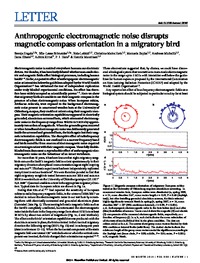 Diese Seite wurde seit 7 Jahren inhaltlich nicht mehr aktualisiert.
Unter Umständen ist sie nicht mehr aktuell.
Diese Seite wurde seit 7 Jahren inhaltlich nicht mehr aktualisiert.
Unter Umständen ist sie nicht mehr aktuell.
 Zusammenfassungen
Zusammenfassungen
Electromagnetic noise is emitted everywhere humans use electronic devices. For decades, it has been hotly debated whether man-made electric and magnetic fields affect biological processes, including human health. So far, no putative effect of anthropogenic electromagnetic noise at intensities below the guidelines adopted by the World Health Organization has withstood the test of independent replication under truly blinded experimental conditions. No effect has therefore been widely accepted as scientifically proven. Here we show that migratory birds are unable to use their magnetic compass in the presence of urban electromagnetic noise. When European robins, Erithacus rubecula, were exposed to the background electromagnetic noise present in unscreened wooden huts at the University of Oldenburg campus, they could not orient using their magnetic compass. Their magnetic orientation capabilities reappeared in electrically grounded, aluminium-screened huts, which attenuated electromagnetic noise in the frequency range from 50 kHz to 5 MHz by approximately two orders of magnitude. When the grounding was removed or when broadband electromagnetic noise was deliberately generated inside the screened and grounded huts, the birds again lost their magnetic orientation capabilities. The disruptive effect of radiofrequency electromagnetic fields is not confined to a narrow frequency band and birds tested far from sources of electromagnetic noise required no screening to orient with their magnetic compass. These fully double-blinded tests document a reproducible effect of anthropogenic electromagnetic noise on the behaviour of an intact vertebrate.
Von Svenja Engels, Nils-Lasse Schneider, Nele Lefeldt, Christine Maira Hein, Manuela Zapka, Andreas Michalik, Dana Elbers, Achim Kittel, P. J. Hore , Henrik Mouritsen im Text Anthropogenic electromagnetic noise disrupts magnetic compass orientation in a migratory bird (2014)  Dieser wissenschaftliche Zeitschriftenartikel erwähnt ...
Dieser wissenschaftliche Zeitschriftenartikel erwähnt ...
 Zitationsgraph (Beta-Test mit vis.js)
Zitationsgraph (Beta-Test mit vis.js)
 1 Erwähnungen
1 Erwähnungen 
- Elektrosmog verwirrt Vögel (Roland Knauer) (2014)

 Anderswo finden
Anderswo finden
 Volltext dieses Dokuments
Volltext dieses Dokuments
 |  Anthropogenic electromagnetic noise disrupts magnetic compass orientation in a migratory bird: Artikel als Volltext ( Anthropogenic electromagnetic noise disrupts magnetic compass orientation in a migratory bird: Artikel als Volltext ( : :  , 5200 kByte; , 5200 kByte;  : :  2021-03-21) 2021-03-21) |
 Anderswo suchen
Anderswo suchen 
 Beat und dieser wissenschaftliche Zeitschriftenartikel
Beat und dieser wissenschaftliche Zeitschriftenartikel
Beat hat Dieser wissenschaftliche Zeitschriftenartikel während seiner Zeit am Institut für Medien und Schule (IMS) ins Biblionetz aufgenommen. Beat besitzt kein physisches, aber ein digitales Exemplar. Eine digitale Version ist auf dem Internet verfügbar (s.o.). Aufgrund der wenigen Einträge im Biblionetz scheint er es nicht wirklich gelesen zu haben. Es gibt bisher auch nur wenige Objekte im Biblionetz, die dieses Werk zitieren.












 Biblionetz-History
Biblionetz-History